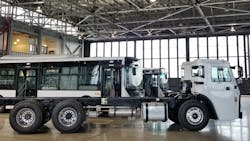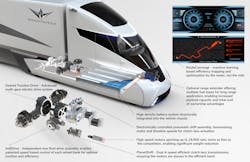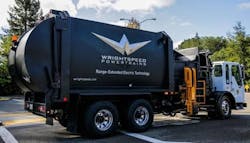Stealthy Wrightspeed ready to make noise in refuse
After 16 years, electric powertrain manufacturer Wrightspeed appears to be at the right place at the right time, with deployments of its long anticipated Route solution for heavy-duty local transport coming this year, just as demand for more fuel efficient trucks is reaching a fever pitch.
Founded in 2005 by Ian Wright, who also co-founded Tesla, the company was one of the first to tackle the decarbonization the heavy-duty truck sector, developing an electric powertrain designed to excel in applications that feature excessive starts and stops, with a primary focus on refuse trucks and buses.
Wrightspeed’s solution called the Route comprises a drop-in electric powertrain that draws additional power from a small displacement piston diesel engine when needed, with more efficiency and performance squeezed from regenerative brakes that work down to 0 mph and a proprietary Geared Traction Drive that uses a four-speed clutchless gearbox and dual motors — spinning up to a 24,000 rpm that allow for higher torque at steep grades.
During a pilot in 2016, the complement of hardware and software was integrated into a Freightliner Condor refuse truck in the San Francisco area, where 30% grades are not uncommon. Wrightspeed reported 60% fuel savings using the turbine-electric range extender on the route over a traditional diesel truck. The technology even earned the company a Technology Pioneer Award by the World Economic Forum in 2016. Since then, there’s been nary a peep out of Wrightspeed’s Alameda, Calif. Office, but the time for stealth is over.
“We've really been focused on the industrialization and getting the product ready to go to market, and so we've been very quiet,” explained Broc TenHouten, Wrightspeed VP of engineering, to FleetOwner. “We've really been working on making sure the product was 100% ready and reliable before we went out and started making any noise.”
Now, with a new CEO, Gilbert Passin, formerly of Mack Trucks, Volvo, Toyota and Tesla, at the helm, and active production at its 110,000 square-foot Alameda factory, the company is ready to trumpet it tech’s capabilities.
“We've gone from something that shows well in the lab and looks good on a prototype, to something that will actually run for thousands or tens of thousands of hours, and something that will perform in the field,” said Wrightspeed Chairman Kevin Landis, who has overseen the company since 2013.
From an efficiency standpoint, Wrightspeed claims a refuse truck with its diesel range-extended electric powertrain more than doubles diesel refuse trucks’ fuel economy, pushing from the average 2.53 mpg to 5.45 mpg.
“Refuse trucks have the worst miles per gallon, and that really makes it a place to target first,” TenHouten said. They get worse mileage because they stop 5 to 10 times per mile, though that has been turned into an advantage with Wrightspeed’s regen brakes, which TenHouten said perform 85% better than competitors.
The electric motor leads to near-silent operation, which would cut down on noise pollution as well as emissions. Wrightspeed’s system also weighs 47% less than a direct drive system, while more than doubling the torque, TenHouten said.
“Those high-speed motors allow them to be extremely lightweight, just like it when you use a DeWalt hand tool,” he offered. “It doesn't have a big motor that turns slow, it has a tiny little high speed motor that runs into a gearbox.”
TenHouten said Wrightspeed found a way to spin the motor at such high speeds without demagnetization. Speed-based control also allows for better traction as well, while redundancy in the system allows for continued operation even if a battery cell goes bad.
The regenerative braking has a dramatic impact on both fuel cost and range, as well as maintenance costs. Every time the truck stops at a house to pick up the trash, the motors take on the brakes’ job, converting the stopping energy in more juice for the battery. The brakes are then spared the burden of impeding forward momentum, extending their life and eliminating the costs of repair and downtime.
TenHouten said for extreme case such as refuse trucks and buses, fleets could save $30,000 per vehicle annually. Buses end up saving more on the fuel side due to their excessive idling waiting for passengers to embark and depart.
Wrightspeed is OEM agnostic, and the solution can be retrofitted. For a new truck with the solution, Wrightspeed estimates a cost of $250,000, and a total cost of ownership after seven years at just under $400,000. The next closest competitor is Hyliion, which uses CNG/RNG range extenders, at $408,000 over the same time period.
TenHouten, who previously worked at General Motors on early hybrid prototypes and medium-duty trucks, could not speak about partner fleets, as they prefer to remain quiet for a competitive advantage.
According to Wrightspeed, fleets would yield an annual savings of $16,173 per vehicle if their calculations are accurate. City bus efficiency jumps from 3.30 mpg to 11.70 mpge for a $29,197 annual savings, while regional heavy haul goes from 7.27 mpg to 10.12 mpge, providing a $7,443 advantage.
While the diesel range extender still has an aftertreatment system (which is Euro VI compliant), a compact turbine engine solution is expected for 2023 that will not require aftertreatment, and could run off CNG as well. A full battery-electric version with a range of 300 miles is also in the works, and the system will be compatible with fuel cells as well.
Fleet data would need to confirm these benefits once trucks equipped with the Route solution are on the road, and Wrightspeed’s telematics platform can “provide energy use information by the house, not just by the mile,” TenHouten said.
As a whole, the company puts a great deal of emphasis on energy conservation within the system.
“The place where there's a lot of wastefulness that you can go back and harvest is all the stopping and starting of heavy vehicles that are on the road all day long,” said Landis.
Because Wrightspeed addressed this issue with technology he discerned was “better at harvesting, all of the momentum that you throw away every time you hit the brakes,” he chose to invest in Wrightspeed.
And the refuse market was a perfect place to hone in on.
“You don't always have to go after the market that appears to be the biggest when you're a startup company, you need to go after a market that's plenty big for you and where you provide the best benefit,” Landis said. “If we just were to look at nothing but garbage trucks, that would be that would be enough for several years for us.”
After eight years, as dozens of challengers have boisterously arrived on the scene, Wrightspeed has found going at its own pace is finally paying off.
“Once we've solved the toughest engineering problems, I think we can go ahead and take some of those easy applications like long haul trucking, and have a go at them,” Landis concluded.
About the Author
John Hitch
Editor
John Hitch is the editor-in-chief of Fleet Maintenance, providing maintenance management and technicians with the the latest information on the tools and strategies to keep their fleets' commercial vehicles moving. He is based out of Cleveland, Ohio, and was previously senior editor for FleetOwner. He previously wrote about manufacturing and advanced technology for IndustryWeek and New Equipment Digest.




